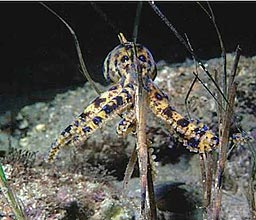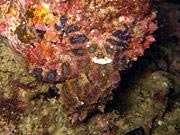: Hapalochlaena fasciata
Phylum Mollusca
The blue-ringed octopuses are a small octopus species that live in tide pools in the Pacific Ocean, from Japan to Australia. There are at least 10 species of the tiny Blue-ringed octopus.
Despite their small size (this species is maximum size 8cm) and relatively docile nature, they are currently recognized as one of the world's most venomous animals. They are recognized by their characteristic blue and black rings and yellowish skin. The blue-ringed octopus uses their dermal chromatophore cells to camouflage themselves until provoked, at which point it quickly changes color, becoming bright yellow with blue rings. Found in shallow rock pools and amongst algae and urchins on temperate reefs.
Two types of poison secreted by two separate poison glands are used against prey and predators. One of the poisons is used for hunting crab,hermit crabs and shrimp, the other, which is extremely toxic, is used as self defense against predators. The poisons are secreted into the Blue ring octopus's saliva, but the mechanism for poisoning its victim is not well understood. Either the poison is expelled in the saliva into the water or the octopus bites its prey or predator.
Once the prey is dead, the octopus begins consuming it with its powerful beak-like mouth. It hunts small crabs, hermit crabs, and shrimp, and may bite humans if provoked or stepped on. The octopus produces venom that contains tetrodotoxin, 5-hydroxytryptamine, hyaluronidase, tyramine, histamine, tryptamine, octopamine, taurine, acetylcholine, and dopamine. Tetrodotoxin blocks sodium channels, causing motor paralysis and sometimes respiratory arrest leading to cardiac arrest due to a lack of oxygen. The toxin is created by bacteria in the salivary glands of the octopus.There is no known antivenom.
|


|
Female Blue-ringed octopus lay only one clutch of about fifty eggs in their lifetime towards the end of Autumn. Eggs are laid then incubated underneath the female's arms for approximately six months, and during this process she will not eat. After the eggs hatch, the female dies.The Blue- ringed octopus is about the size of a pea when hatched then grows to reach the size of a golf ball as an adult. They mature quickly and begin mating the following autumn. Males die after mating. Octopuses, along with squid and cuttlefishes have a short lifespan of about 2 years.
All blue ringed octopus species are considered threatened due to over collection and habitat loss and are CITES listed as having international trade protection status |